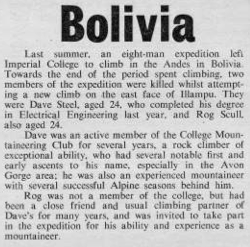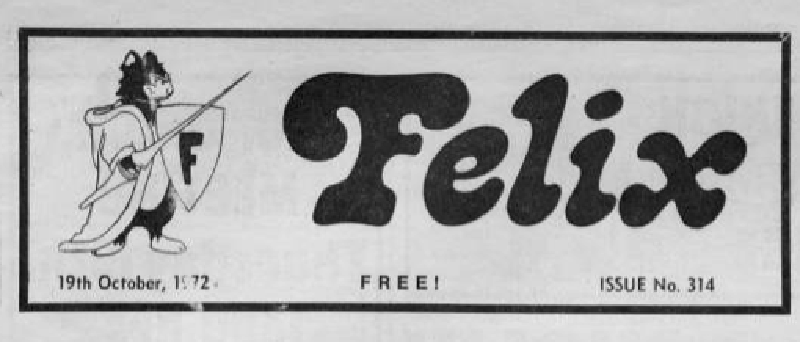The edition of Imperial College’s student newspaper, Felix, from the 19th of Oct 1972, details two accident reports on ICMC-affiliated trips. You can find the article (and the rest of this edition of Felix) in the link below:
An expedition report from the Cordillera Real (Bolivian) expedition can also be found here: Click here to download
The two articles and their transcription can be found below:


Transcription
Bolivia
Last summer, an eight-man expedition left Imperial College to climb in the Andes in Bolivia. Towards the end of the period spent climbing, two members of the expedition were killed whilst attempting a new climb on the east face of Illampu. They were Dave Steel, aged 24, who completed his degree in Electrical Engineering last year, and Rog Scull also aged 24. Dave was an active member of the College Moun taineering Club for several years, a rock climber of exceptional ability, who had several notable first and early ascents to his name, especially in the Avon Gorge area; he was also an experienced mountaineer with several successful Alpine seasons behind him. Rog was not a member of the college, but had been a close friend and usual climbing partner of Dave’s for many years, and was invited to take part in the expedition for his ability and experience as a mountaineer.
Caucasus
The IC Mountaineering Club sent an expedition to the Caucasus this summer. Its plans were to spend some six weeks climbing in the Caucasus mountains during July and August, but after a short time in Russia, it was realised that the local restrictions and controls placed upon the party in the mountains would prevent the group from achieving any significant climbs whatsoever. After two weeks, the members of the expedition decided to leave Russia and travel to the French Alps. The group had been in Chamonix for about ten days when the tragedy occurred.
On Saturday, 29th July, Graham Groarke and Keith Skelton left Chamonix for the Argentierre Hut about five miles up the valley from Chamonix. They planned to do two climbs from the hut, both popular and well frequented routes. The first on the Sunday was to be a route known as the ENE buttress and NE slope of Les Courtes. The second which they intended to climb on Monday was to have been a traverse of Le Tour Noir They were expected back at camp in Chamonix on Monday evening.
They did not return on Monday evening, but those left in camp were not unduly worried by their non-appearance. The weather had become cloudy during the afternoon, and it was assumed they were spending another night in the hut and would come down the following morning. The alarm was raised at 2 p.m. on Tuesday afternoon (1st August) when they had not arrived. The special high mountain branch of the police were notified. They telephoned the warden of the Argentierre hut, who said that Groarke and Skelton had left at 2 a.m. on Sunday morning to climb Les Courtes (3,800 m) and had not returned to the hut. The warden has assumed they were going on down the other side of the mountain to a different hut, the Couvercle, after completing their climb. He said that a French party had passed them about half way up the climb and reported that the two Englishmen were going well… if a little slowly. The French party who had not ‘seen them again after passing them completed the climb and returned to the Argentierre Hut’. The Warden of the Couvercle Hut was then telephoned, and said that he had seen no sign of the pair. Both Wardens reported their areas in heavy mist. The police said that they would send their helicopter to search as soon as the mist cleared up a little.
The helicopter went up at first light on Wednesday morning. The bodies of Graham and Keith were found almost immediately at the foot of the ENE buttress of Les Courtes, and were brought down to Chamonix. It was judged that the pair had fallen a long way possibly from near the top of the climb which was 1,800 feet from start to finish. There was no obvious reason as to the cause of the accident. Both Keith and Graham were experienced climbers and the route was well within their capabilities. It is felt that the most likely explanation of the cause of the accident is that the pair had taken an unduly long time on the early rock section of the climb and found themselves on the upper snow field in the late afternoon when the snow was soft and unstable. It is almost impossible to belay or perform an ice axe arrest in soft wet snow. They would by then have been quite tired and one slip would have been enough to pull both ment from the face.
Whatever happened, the loss of two good friends was a severe blow to the expedition and the Mountaineering Club.
It is through these stories that we must remember to face the mountain with respect and treasure the times we can spend with our friends. Watch out for your mates when you’re out on the mountain. (Comment from 2023)
